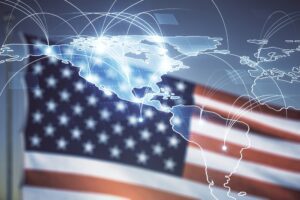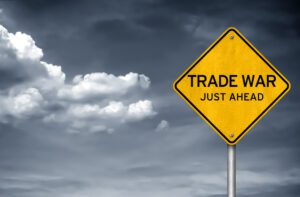Event Video: Global Governance of Artificial Intelligence
On June 5, WITA, in partnership with the U.S. Council for International Business, hosted a discussion of efforts to create a global regulatory framework for Artificial Intelligence (AI) and the recommendations of the OECD’s Council on Artificial Intelligence.
Featured Speakers:
Dr. Orit Frenkel, CEO and co-founder of the American Leadership Initiative. She recently co-authored the paper, U.S. Leadership on AI Global Governance
Kate Goodloe, Managing Director at BSA | The Software Alliance
Karine Perset, Head of the AI Unit and OECD.AI at the OECD Digital Economy Policy Division
David C. Turnbull, U.S. Delegate to the OECD Digital Policy Committee & GPAI in the Bureau of Cyberspace and Digital Policy at the Office of Multilateral Affairs in the U.S. Department of State
Howard Wachtel, Senior Director and Head of UN and International Organizations Policy at Microsoft
Moderator: Cheryl Miller, Vice President of Digital Policy at the U.S. Council for International Business
06/05/2024 | Washington International Trade Association, in partnership with the U.S. Council for International Business
Revitalizing U.S. Trade Remedy Tools for an Era of Industrial Policy in an Interconnected World
There is a saying in sports that baseball is a game built for radio, while football is a game built for TV. Baseball moves slowly enough that in between pitches, the announcer can describe the intricacies of the game: the weather, the pitcher’s glove, or the mannerisms of the hitter. Football moves faster and can be enjoyed with far less explanation. The United States’ trade enforcement toolkit is similarly built for radio. Its tools—largely tariffs—are outdated and in need of an update for a contemporary audience: in this case, a modern, globally connected economy.
This is not to suggest that trade enforcement, or tariffs more broadly, are bad—or even a net negative. When used effectively, the country’s trade enforcement authorities are a bulwark against job losses and an important tool for industries to use when facing illegal or subsidized import competition. Indeed, smart, targeted tariffs—whether or not used as a trade remedy—can play an important role in reorienting and de-risking global supply chains, or even catalyzing broad industrial decarbonization.
But too often, tariffs or other trade enforcement actions fail to achieve their greatest possible impact, not because policymakers are stubborn or foolish, but because the tools themselves offer little in terms of precision, timeliness, or collaboration. In fact, the process of requesting trade enforcement support, the process of affording that support, and the impact of trade remedies when provided has so often failed to meet the needs of workers and companies, that broad frustration with the country’s existing trade remedy authorities is one issue that seems to unite boardrooms and union halls alike.
Clearly an update is needed. And the timing is right too. If the Biden administration’s unprecedented investments in American industry are to reach their full transformational potential, then a reimagined trade enforcement toolkit is critical. Without it, potential benefits that could support the United States’ workers, its economy, and the economies of its partners and allies, as well as its vital interests and values, may go unrealized.
What is more, the out-of-date nature of the existing trade enforcement toolkit has placed the United States in a disadvantageous position vis-a-vis China and other authoritarian nonmarket economies, precisely at a time when global competition is increasing, and American businesses and workers are looking to the government for more effective support.
06/03/2024 | Ryan Mulholland | Center for American Progress
The Dangerous Retreat Into Protectionism
Carl Bildt is a former prime minister and foreign minister of Sweden.
Trade barriers, tariffs and other protectionist tools are starting to feature more prominently around the world, often appearing under the heading of economic security. The decision by President Joe Biden’s administration this month to quadruple US tariffs on Chinese electric vehicles to 100 percent, as well as doubling the tariff on solar cells (to 50 percent) and more than tripling the tariff on lithium-ion EV batteries (to 25 percent), represents a momentous new step in this direction.
Until now, US restrictions on trade with China had been justified on national-security grounds, to prevent the Chinese military from acquiring sensitive technologies. While one could debate whether this policy made sense, it at least seemed to fit into a longer-term strategy. But these latest protectionist measures have nothing to do with China’s military capabilities. Instead, they aim solely to prevent cheaper, often better, green technologies from reaching US consumers.
The connection to the US election is obvious. Biden has been trying to head off Donald Trump by playing to the same protectionist sentiments that Trump, the presumptive Republican nominee, has been stoking for years. It was Trump, after all, who put the world on a new protectionist path when he imposed sweeping tariffs on steel, aluminium and many imports from China. Keen not to be outdone by Biden, he has already said that he would double the tariff on Chinese EVs from Mexico and apply additional ones to an even wider range of products.
Even taken in isolation, such measures are expensive and counterproductive. Tariffs impose higher costs on consumers and reduce competitive pressures, and thus innovation. In this case, they will also impede the transition to a net-zero-emissions economy. There are no economically redeeming features to the policy. Worse, the latest round of protectionist measures is part of an increasingly disturbing and dangerous trend. Step by step, major powers are unravelling an international economic order that delivered enormous gains over many decades through trade integration and globalisation.
05/31/2024 | Carl Bildt | The Strategist
Election Smoke & Mirrors: Assessing Biden’s Recent Tariff Moves Against China
Following is an excerpt from a column by Simon J. Evenett, published by the IMD on June 4.
Unlike President Trump’s across-the-board import tax increases on Chinese goods in 2018 and 2019, the tariff increases announced on 14 May 2024 by the Biden Administration will affect just 14 product categories. The Biden Administration prefers selective decoupling from China, which is restricted to a limited number of sensitive sectors. Just $18bn of Chinese imports are expected to be affected, less than 5% of total Chinese annual imports to the United States…
So, is Biden’s move no big deal?
Not so fast. Where Trump was erratic and transactional in his dealings with China, Biden’s team has been methodical and persistent. Current US Administration officials deemphasize decoupling from the Chinese economies but reckon there needs to be “a small yard and a high fence.” By this, they mean that some sectors and technologies are — or should become — off-limits to Chinese buyers, firms, and investors. A ramping up of restrictions on inbound and outbound investments and technology sales involving all or selected Chinese firms has been the hallmark of Biden’s first-term trade policy.
Indeed, the May 2024 tariff measures apply to some sensitive sectors where China is effectively excluded from US markets. Those tariff measures often involve eye-watering increases in import taxes (up to 100% in some cases and far in excess of what Trump imposed), which is a testament to the height of the fence Biden seeks.
If the Biden team could state once and for all the commercial deals it is prepared to allow and those it doesn’t, then executives could plan. However, technology evolves over time — as do Chinese tactics to circumvent US controls — and, not unreasonably, Washington, D.C., reserves the right to change the terms of commercial engagement with China.
This raises fears that the yard will expand over time and the fence will get higher — even if Biden wins re-election. Such situations clearly call for scenario planning. After all, Trump’s plans for higher tariffs on China’s imports are well known.
06/04/2024 | Simon J. Evenett | International Institute for Management Development (IMD)
Trump’s Proposed Blanket Tariffs Would Risk a Global Trade War
Former President Donald Trump has promised more tariffs if reelected, 60 percent against Chinese goods, 10 percent against products from the rest of the world. These are in addition to the tariffs he imposed during his time in office and presumably on top of some noteworthy tariffs added to by President Joseph R. Biden, Jr., including the 100 percent tariff on Chinese-made electric vehicles (EVs). China was considered a strategic competitor under the former Trump administration’s National Security Strategy; other countries were not. Into this “rest of the world” category fit allies, neighbors, and just innocent bystanders.
Why 10 percent? Why all countries? There is no other reasonable explanation than that Trump considers all trade to be “unfair” in some respect, or at least disadvantageous.
This isn’t normally the way presidents act when it comes to tariffs. Additional tariffs are generally imposed very selectively, under trade remedy statutes crafted by Congress. They are actions taken pursuant to a finding that a particular product is involved in a specified unfair trade act, or it may be that the new tariff is a surgical retaliatory measure to open a market for a specified American product.
Many uncertainties surround Trump’s proposals.
We don’t know why 10 percent was chosen or why it would remain at 10 percent once imposed, but we do take Trump at his word on tariff matters—think about his fulfilling his pledge on day one of his time in office to withdraw the United States from the Transpacific Partnership (TPP) negotiated by President Barack Obama with Asia Pacific countries. He also already applied tariffs at a level of his choosing, first to steel and aluminum imports, and then to most imports from China, which netted out to 19 percent, a third of what he is promising now.
But didn’t President Biden just put on massive tariffs on Chinese goods? It is true he kept his predecessor’s blanket China tariff and then added some very high selective tariffs of his own. The new Biden tariffs place 50 percent tariffs on semiconductor imports from China. But that trade is modest, just under $1 billion a year. This compares with US chip imports from all sources that amount to about $6 billion each month.
05/29/2024 | Alan Wm. Wolff | Peterson Institute for International Economics
WITA – We put the community in trade community.
Information about upcoming WITA and trade community events






